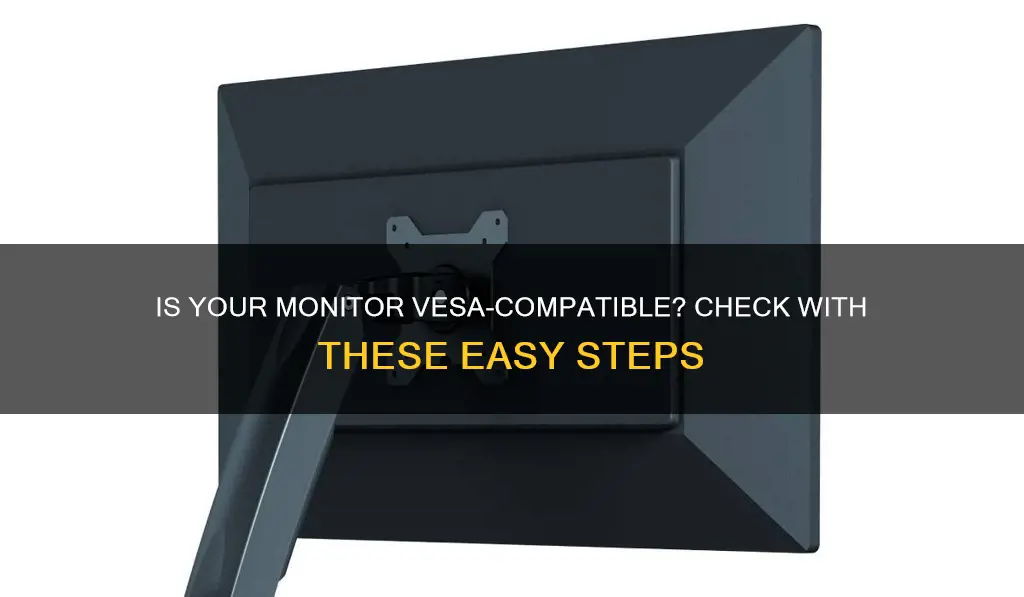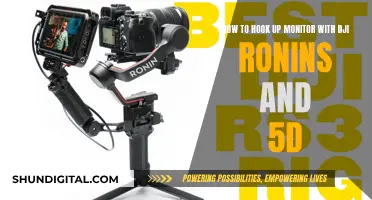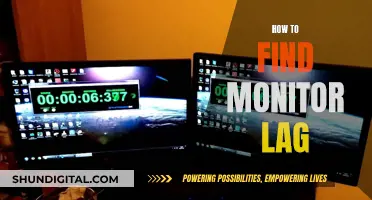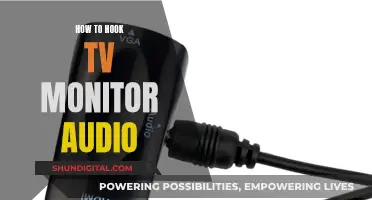
VESA stands for Video Electronics Standards Association, an organisation that creates standards for the consumer electronics industry. VESA-compliant monitors follow an industry-standard mounting system. To tell if your monitor is VESA-compliant, look for a square screw hole pattern on the back of your monitor. The pattern should be 75mm or 100mm. If you don't see one, you can remove the base from the monitor and check again. If you still can't see one, your monitor is not VESA-compliant.
What You'll Learn

Look for a square screw pattern on the back of your monitor
To determine whether your monitor is VESA-compliant, you'll need to inspect the back of the screen. Specifically, you should look for a square screw pattern, which is a standard mounting system. This will typically be a 75mm (about 3″) or 100mm (about 4″) square screw hole pattern.
The VESA mounting is usually situated in the middle of the back of the monitor. If you can't see it, try removing the base of the monitor. You can refer to your monitor's user guide for instructions on how to do this.
Once you've located the screw pattern, you can measure the horizontal and vertical distance between the screw holes (centre to centre) to determine the VESA standard. For example, if the distance between the holes is 400mm wide and 200mm tall, this corresponds to a VESA measurement of 400 x 200mm.
If you can't identify a square screw pattern on the back of your monitor, it may still be VESA-compatible. Some monitors have a curved back that can't accommodate a VESA mount, but the included stand may attach in some other way. You can also refer to your monitor's spec sheet or user guide to check for VESA capability.
Finding the Right Monitor Size for You
You may want to see also

Measure the distance between the holes
To measure the VESA standard of your monitor, you will need to measure the distance between the holes on the back of your screen. These holes will be positioned to make a square or rectangular shape. Measure the distance between the top and bottom holes and the left and right holes in millimetres. Put those numbers together, and you have your VESA pattern. For example, if the distance between the left and right holes is 400mm and the distance between the top and bottom holes is 200mm, your VESA pattern is 400mm x 200mm.
Most standard computer monitors are 100mm x 100mm, but some models vary in size, ranging from 75mm x 75mm to 200mm x 200mm. TV screens are generally larger, measuring up to 800mm x 400mm and beyond. The larger the screen, the larger the VESA measurements are likely to be. Common VESA standards are 75 x 75 mm, 100 x 100 mm, 200 x 100 mm and 200 x 200 mm.
If you are measuring in inches, remember to convert to millimetres (1 inch = 25.4 mm).
Analog vs Digital Monitors: How to Distinguish?
You may want to see also

Check the manual or product information
If you want to know whether your monitor is VESA-compliant, you can check the manual or product information that came with your monitor. If you no longer have the manual, you can try searching online for the specific model of your monitor.
VESA-compliant monitors follow an industry-standard mounting system. There will be a 75mm (about 3″) or 100mm (about 4″) square screw hole pattern on the back of your monitor. If you do not see one, you may need to remove the base from the monitor. You can refer to your monitor’s user guide for instructions on how to do this.
The VESA mounting is typically in the middle of the back of the monitor. The base column of the screen is often fixed at the VESA mounting. If you see threaded holes, you can measure the horizontal and vertical distance between them (centre to centre). If the distance between the holes is 400mm wide and the height is 200mm, this corresponds to a VESA measurement of 400 x 200mm (VESA norm = horizontal distance in mm x vertical distance in mm). The 400x200 comply with the VESA MIS-F standard.
There are three common VESA standards: VESA MIS-D, VESA MIS-E and VESA MIS-F. Monitors up to 14 kg usually have the VESA-MIS-D port, which has a square hole pattern of 75x75 or 100x100 mm. VESA MIS-E-compliant monitors are equipped with a rectangular hole pattern of 200x100 mm and carry up to 23 kg. Large televisions usually have the VESA MIS-F standard, which has a hole pattern of 200mm pitch (e.g. 400x200, 600x400mm).
Touchscreen Monitors: Understanding Their Various Sizes
You may want to see also

Search for your monitor model online
If you are unsure whether your monitor is VESA-compliant, you can search for its model online. The manual or product information that came with your monitor should include details of its VESA compatibility. If you no longer have the manual, you can likely find it online by searching for the specific model of your screen.
If you are still unsure, you can measure the VESA pattern yourself. Measure the distance between the holes on the back of your screen in millimetres. Measure both the distance between the top and bottom holes and the left and right holes. These measurements will give you your VESA pattern.
Most standard computer monitors are 100mm x 100mm, but some models vary in size, ranging from 75mm x 75mm to 200mm x 200mm. TV screens are usually larger, measuring up to 800mm x 400mm and beyond.
How LCD Screens Emit Light
You may want to see also

Use a VESA adapter if your monitor is not VESA-compliant
If your monitor is not VESA-compliant, you can still mount it using a VESA adapter kit. These kits are easily available in the market and can be purchased online.
To find the right VESA adapter kit for your monitor, first note down the measurements and weight of your monitor. Then, visit a trusted online store and check if the specifications of the VESA adapter kits match your monitor's specifications. If you are unable to find a suitable kit, you can contact the brand to find a product that matches your requirements.
There are two types of VESA adapter kits: those designed for specific computer brands, and universal kits that are compatible with almost all types of flat-screen monitors.
Once you have purchased the correct VESA adapter kit, you can attach the adapter to the VESA monitor arm stand. Then, attach your monitor to the converted monitor arm.
You will need a screwdriver and a wrench to complete the process. If your monitor is screwed to its base, carefully remove the screws before attaching the monitor to the arm.
In addition to using a VESA adapter kit, you can also contact your monitor's manufacturer to enquire about mounting alternatives or compatibility options.
Attaching Logitech Webcam to Monitor: An Easy Guide
You may want to see also
Frequently asked questions
VESA-compliant monitors follow an industry-standard mounting system. There will be a 75mm (about 3″) or 100mm (about 4″) square screw hole pattern on the back of your monitor. If you do not see one, refer to your monitor’s user guide for instructions on how to remove the base from the monitor.
You can find your VESA compatibility in the manual or product information that came with your monitor or TV screen. If you no longer have the manual, you can search online for the specific model of your screen. You can also measure the VESA pattern yourself by measuring the distance between the holes on the back of your screen.
VESA mounting patterns are the standardized measurements used to mount screens to universal monitor mounts, TV stands, or wall mounts. The Video Electronics Standards Association (VESA) is an organization dedicated to creating standards in the consumer electronics industry.
If your screen doesn’t have a VESA pattern, it may have a proprietary mounting design that is only compatible with monitor mounts designed specifically for that particular line. You can purchase a VESA adapter that will allow you to use a VESA-compliant mount with your screen.







